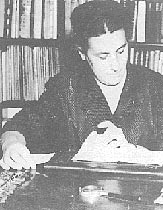

![]()
![]()
|
Newsletter of the District of Asia September-October 1999
In the 1950 Christmas message, Pope Pius XII announced “to the City and to the World” that the actual tomb of St. Peter had been located in the midst of a necropolis buried by Constantine’s Basilica on the Vatican Hill. Among the first of the early visitors of the necropolis (granted the privilege by Pope Pius XII himself) was a member of the faculty of the University of Rome, a professor of Greek epigraphy, Dr. Margherita Guarducci. She arrived on the scene in May 1952, anxious to study the tantalizing, still only partially deciphered Peter graffito in the Valerius tomb. Just fifty years old, Dr. Guarducci brought with her a background of experience that few could equal. The many thousands of hours she had spent peering at ancient epigraphs of all sorts – words incised on worn marble or scratched on stone now crumbling, epitaphs chiseled on moldering graves and monuments, mottoes embossed on medals, plate, old coins, and every other sort of durable material – had marvelously sharpened both her searching eye and her intuitive perception. Especially in the arduous task of unraveling graffiti of a more haphazard kind, doubly alien to modern eyes in its cursive nature and heedless execution, she could frequently almost discern the personality behind the dead hand that had made it. Unmarried, for nearly thirty years she had poured all her energies into scholarship, becoming deeply learned in the ancient Greek and Roman civilizations. Before setting to work, with Monsignor Vacchini she completed a tour of the necropolis, coming finally to the jumble of names crowded onto the surface of the graffiti wall beside Peter’s grave. This feature of the excavations had been described in the official report, very briefly, as a highly interesting but essentially straightforward collection of names and prayers, of the sort often found at venerated graves in antiquity. There had been no sign that anything more unusual was present, and lacking, as it apparently did, any real challenge for an expert, the wall had failed to arouse in Dr. Guarducci more than a mild curiosity. Now, standing only two feet away from it, with Monsignor Vacchni carefully angling his light to bring out the shallow scratches, she was surprised and puzzled by what she saw, even a little shocked. They were indeed many names, crowding against and over one another, along with prayers and invocations. These her practiced eye was readily able to pick out from the tangle. But she was abruptly struck by another element, something very odd, but which had received no comment in the report. In most of the names, almost every individual letter was heavily festooned with additional short scratches, seemingly random lines trailing off at all angles and crisscrossing each other haphazardly. Even the spaces between the names and words, above and below, which would ordinarily have been blank, were filled with this strangely web-like pattern of strung-together lines. The total effect was one of rampant confusion, almost mindless, yet with an underlying, if not quite definable, feeling of purpose.
This was the sight which, in all her pursuit of ancient inscriptions, Dr. Guarducci had never before encountered. In the catacombs and other early Christian cemeteries, the walls at many points have been covered by epigraphs. But in none of these were the inscriptions so heaped up, or embedded in such an angry matrix of inextricable lines. Soon after her work in Valerius tomb, she was burning to know what purpose, if any, could possibly be served by that giddy mass of extraneous, apparently senseless lines on the graffiti wall.
|

